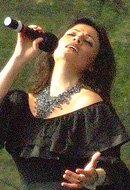
The origins of the language lie in medieval Jewish transliterations of Spanish and other Romance languages into the Hebrew (and Arabic) alphabet. After the expulsion from Spain in 1492, Ladino came into its own as a separate idiom and as the lingua franca of the Sephardi Diaspora in the Balkans and Asia Minor, chiefly as a spoken language but eventually also in print.
Ladino’s fortunes would intimately be tied, for better or worse, to those of the Ottoman Empire. Within that multi-confessional, millet system, non-Muslim minorities, formally powerless, were recognized as legitimate sub-groups not only by religion but also by language. In places like Constantinople, Salonica, Adrianople, and Izmir, Jews and the Ladino language thus thrived together. While much of Jewish intellectual life continued to take place in Hebrew, Ladino made its presence felt in practical halakhic manuals and translations of classic texts (most famously a 1547 Pentateuch in Ladino from the press of Eliezer Gershon Soncino).
Later centuries saw a surge of Judeo-Spanish creativity, inspired in large part by what is undoubtedly Ladino’s greatest work: an encyclopedic Bible commentary titled Me’am Lo’ez (literally, “from a people of strange tongue,” Psalms 114.1). This was the brainchild of Yaakov Khuli (1689–1732), Jerusalemite scion of a distinguished scholarly dynasty who arrived in Constantinople in 1714 to serve as a rabbinical judge. Spurred by the new possibilities afforded by print, as well as by a sense of responsibility for the spiritual health of a community still reeling from the Sabbatian heresies of the previous century, Khuli undertook a massive enterprise of public education, of which Me’am Lo’ez was a chief instrument.
The first volume, on Genesis, appeared in 1730; Khuli completed half of the volume on Exodus before his death in 1732. In the work he draws on rabbinic literature, biblical exegesis, the Zohar, and the rich legal, philosophical, and mystical sources of Sephardi Jewry to forge both simple homilies and intricate discourses. His purpose, he writes in the introduction, is to inculcate four basic ideas: the wonder of God’s creation, the centrality of Torah and its commandments, love of one’s neighbor, and the fact of mortality. Armed with these, the reader “will know that man’s end is to vanish from this world, and so he must take care to win companions that will stand with him in times of adversity, just as one does before embarking on a journey.”
Me’am Lo’ez triggered a new wave of rabbinic writing, manifest above all in efforts to complete Khuli’s work. In her contribution to an ongoing series on the state of Ladino studies in the journal European Judaism, the scholar Alisa Meyuhas Ginio traces the evolution of the Ottoman rabbinate from the classic work of Khuli and his immediate successors, all of whom were steeped in classical learning and literary style, through a transitional era of figures neither so erudite nor so fluid, to, in the late-19th century, authors influenced by modernization and the European Enlightenment.
It was in these latter decades that, as a literary language, Ladino entered its Golden Age, catalyzed (as Sarah Abrevaya Stein shows in her fascinating book, Making Jews Modern ) by the radical uncertainties of modernity and the cultural hungers of new generations of urban readers. Although, as Michael Alpert notes in European Judaism, Ladino novelists were not on a par with their counterparts in Hebrew and Yiddish (indeed, the vast majority of Ladino novels were translations), magazines and journalism were another story.
The first Ladino newspaper, Sha’arei Mizrah, was launched in 1845. From 1860 on, Ladino journalism flourished, grappling with the major social and cultural issues of the day and becoming the primary forum for pioneering studies of the history and culture of Sephardi Jewry. In the 20th century, there were some 300 Ladino periodicals in Turkey and the Balkans in the period between the two world wars.
Ladino culture as a whole could not and did not outlast the Ottoman setting that had given it shape and coherence. Already in the interwar years, the periodicals were fissuring into narrowly segmented audiences; fewer young people spoke the language; and the older texts, printed in the classic “Rashi” typeface, were sealed into the past. The Holocaust and, later, waves of emigration to Israel and the West largely finished off what remained of a lived culture.
And today, when the Ottomans are no more and Turkish Jewry is on the ropes? Unlike Yiddish, Ladino lacks both communities of speakers in the present and enough original literature of the past to leave a canon of its own. Nor did it play a role in setting the ideological terms or creating the leading institutions either of Israel or of American Jewry.
And yet it still has much to offer. The Italian poet Eugenio Montale once wrote of “the second life of art,” in which the fragments and traces of an original poem, painting, or novel make their way “back into the streets” and into people’s minds, in new and unintended ways but of a piece with the evolving consciousness of the tribe. It may be just so in the second life of Ladino and its treasures, from Me’am Lo’ez and other rabbinic works, to the feats of historical research performed by early scholars, to the political and cultural debates that enlivened the pages of Ladino periodicals.
And then there is the music, both sacred and secular: music that is being rediscovered and reinterpreted by scholars in Europe, Israel, and the U.S., and by artists from Yasmin Levy, daughter of a Ladino composer and cantor, to the Brooklyn-born musician Basya Schechter. In an increasingly globalized world, the recovery of several centuries’ worth of Jewish experience, situated at a geopolitical crossroads all its own and set at a different angle from the usual pattern of modern Jewish history, is no small gift.


Artículos Relacionados: